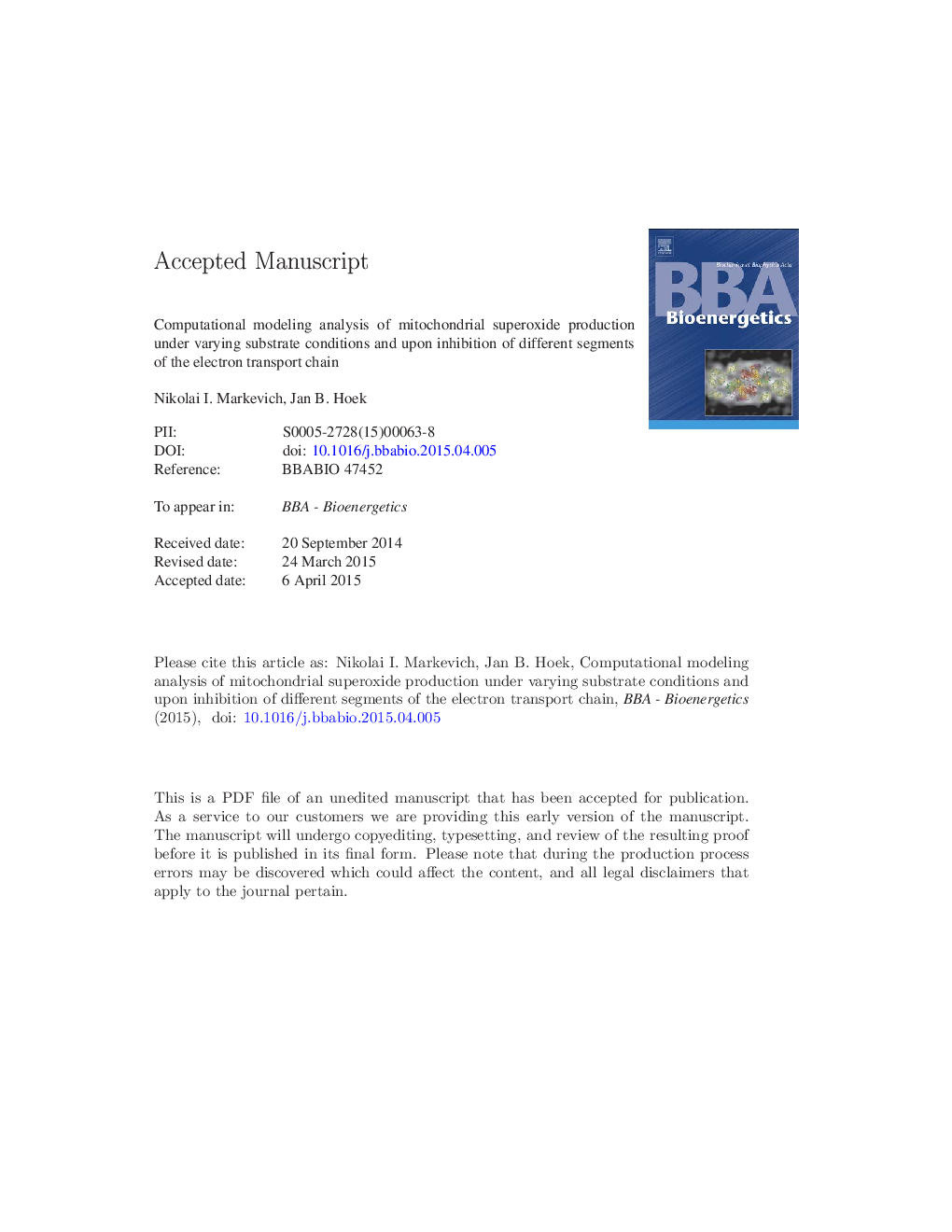| کد مقاله | کد نشریه | سال انتشار | مقاله انگلیسی | نسخه تمام متن |
|---|---|---|---|---|
| 8298734 | 1537041 | 2015 | 52 صفحه PDF | دانلود رایگان |
عنوان انگلیسی مقاله ISI
Computational modeling analysis of mitochondrial superoxide production under varying substrate conditions and upon inhibition of different segments of the electron transport chain
ترجمه فارسی عنوان
تجزیه و تحلیل مدل سازی محاسباتی تولید سوپراکسید میتوکندری تحت شرایط مختلف بستر و با مهار بخش های مختلف زنجیره حمل و نقل الکترون
دانلود مقاله + سفارش ترجمه
دانلود مقاله ISI انگلیسی
رایگان برای ایرانیان
کلمات کلیدی
زنجیره تنفسی، سوپراکسید، نیمهکینون، پتانسیل غشاء، مدل محاسباتی، تجزیه و تحلیل مهار کننده،
موضوعات مرتبط
علوم زیستی و بیوفناوری
علوم کشاورزی و بیولوژیک
دانش گیاه شناسی
چکیده انگلیسی
A computational mechanistic model of superoxide (O2
- â) formation in the mitochondrial electron transport chain (ETC) was developed to facilitate the quantitative analysis of factors controlling mitochondrial O2
- â production and assist in the interpretation of experimental studies. The model takes into account all individual electron transfer reactions in Complexes I and III. The model accounts for multiple, often seemingly contradictory observations on the effects of ÎΨ and ÎpH, and for the effects of multiple substrate and inhibitor conditions, including differential effects of Complex III inhibitors antimycin A, myxothiazol and stigmatellin. Simulation results confirm that, in addition to O2
- â formation in Complex III and at the flavin site of Complex I, the quinone binding site of Complex I is an additional superoxide generating site that accounts for experimental observations on O2
- â production during reverse electron transfer. However, our simulation results predict that, when cytochrome c oxidase is inhibited during oxidation of succinate, ROS production at this site is eliminated and almost all superoxide in Complex I is generated by reduced FMN, even when the redox pressure for reverse electron transfer from succinate is strong. In addition, the model indicates that conflicting literature data on the kinetics of electron transfer in Complex III involving the iron-sulfur protein-cytochrome bL complex can be resolved in favor of a dissociation of the protein only after electron transfer to cytochrome bH. The model predictions can be helpful in understanding factors driving mitochondrial superoxide formation in intact cells and tissues.
- â) formation in the mitochondrial electron transport chain (ETC) was developed to facilitate the quantitative analysis of factors controlling mitochondrial O2
- â production and assist in the interpretation of experimental studies. The model takes into account all individual electron transfer reactions in Complexes I and III. The model accounts for multiple, often seemingly contradictory observations on the effects of ÎΨ and ÎpH, and for the effects of multiple substrate and inhibitor conditions, including differential effects of Complex III inhibitors antimycin A, myxothiazol and stigmatellin. Simulation results confirm that, in addition to O2
- â formation in Complex III and at the flavin site of Complex I, the quinone binding site of Complex I is an additional superoxide generating site that accounts for experimental observations on O2
- â production during reverse electron transfer. However, our simulation results predict that, when cytochrome c oxidase is inhibited during oxidation of succinate, ROS production at this site is eliminated and almost all superoxide in Complex I is generated by reduced FMN, even when the redox pressure for reverse electron transfer from succinate is strong. In addition, the model indicates that conflicting literature data on the kinetics of electron transfer in Complex III involving the iron-sulfur protein-cytochrome bL complex can be resolved in favor of a dissociation of the protein only after electron transfer to cytochrome bH. The model predictions can be helpful in understanding factors driving mitochondrial superoxide formation in intact cells and tissues.
ناشر
Database: Elsevier - ScienceDirect (ساینس دایرکت)
Journal: Biochimica et Biophysica Acta (BBA) - Bioenergetics - Volume 1847, Issues 6â7, JuneâJuly 2015, Pages 656-679
Journal: Biochimica et Biophysica Acta (BBA) - Bioenergetics - Volume 1847, Issues 6â7, JuneâJuly 2015, Pages 656-679
نویسندگان
Nikolai I. Markevich, Jan B. Hoek,
